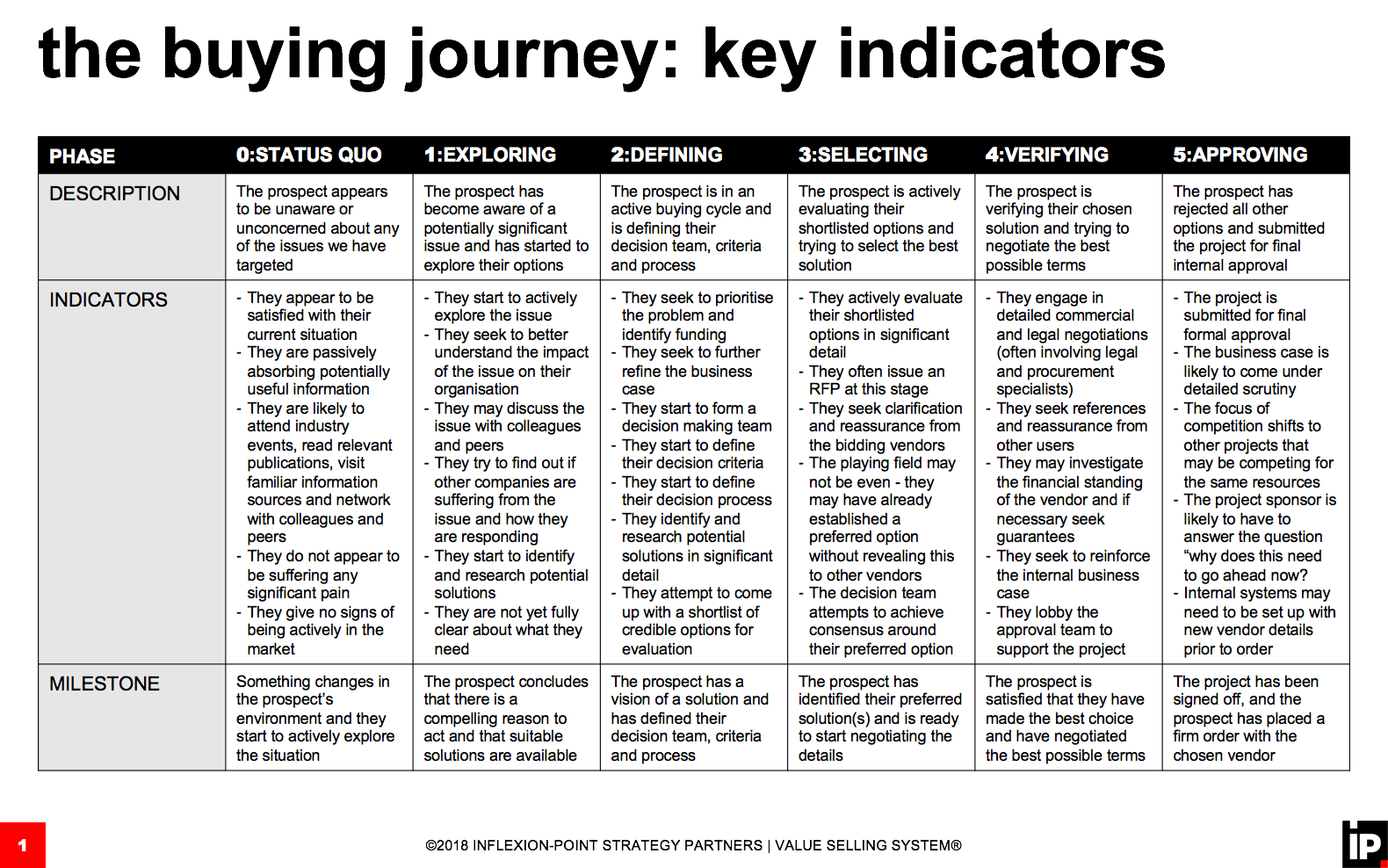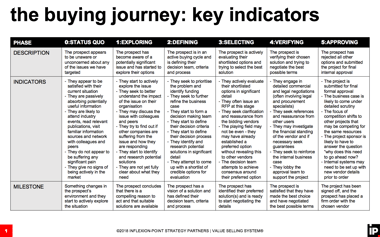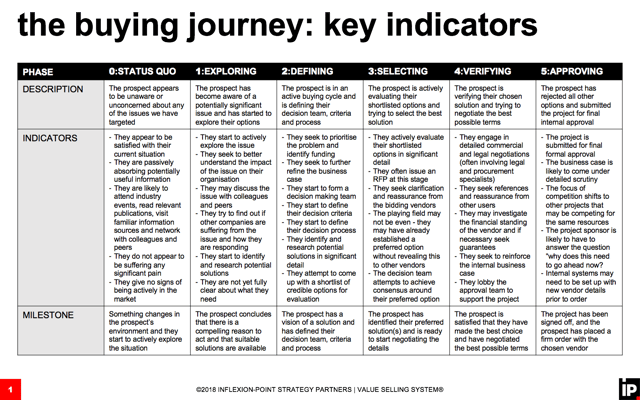Where is your prospect in their buying journey?
January 2, 2018

 One of the main reasons why apparently well-qualified sales opportunities fail to close or move forward is that the sales person is so intent on pursuing their sales campaign that they fail to accurately diagnose where their prospect is in their buying journey.
One of the main reasons why apparently well-qualified sales opportunities fail to close or move forward is that the sales person is so intent on pursuing their sales campaign that they fail to accurately diagnose where their prospect is in their buying journey.
This misdiagnosis is at the heart of many common current sales challenges, particularly when opportunities fail to close when predicted.
The problem can exist regardless of whether or not the sales person is following a defined “sales process”, although it’s interesting (and somewhat disturbing) to observe that some poorly designed sales processes actually serve to obscure this critical piece of information.
It ought to be obvious, oughtn’t it, that if we don’t know where our prospect really is in their buying decision process, the chances that we are going to make the best possible decisions about how to pursue the opportunity are pretty remote.
That’s why accurately diagnosing the current state of our prospect’s buying journey is so important…
Many potential “champions” turn out to inexperienced buyers. Some prospect organisations don’t actually have well-defined buying processes. If you suspect either or both of these situations is at play, rather than ignoring it and hoping it will resolve itself (it won’t) you’re much better off coaching your champion in how to manage their buying journey. But that’s a topic for another blog.
There’s a remarkably consistent pattern to most successful buying processes (the ones that end in a positive outcome, rather than a decision to “do nothing”), and although it’s always possible for some opportunities to skip some of the stages, this almost always creates significant problems for the prospect, causing the project to stall or fail later on.
KEY PHASES IN THE BUYING JOURNEY
Here are the seven phases that are most commonly found in successful complex B2B buying journeys, including the “pre-buying” STATUS QUO and the post-sale IMPLEMENTATION stages. These apply particularly to high-value first-time purchases that involve multiple stakeholders (lower value, transactional purchases are often simpler):
- STATUS QUO [Pre-Buying]
- EXPLORING
- DEFINING
- SELECTING
- VERIFYING
- APPROVING
- IMPLEMENTING [Post-Sale]
Although each phase normally proves to be important, the buying journey itself is not necessarily linear. At any point, the prospect can decide to stay as they are, go around in circles, move forwards, move backwards, or abandon the process altogether.
Different members of the key stakeholder group/decision-making team may think that the project is at a different phase to their colleagues. The project’s Power Sponsor has a critical role in identifying and dealing with these misalignments.
Let’s look at each of these phases and their associated indicators and milestones in more detail…
0: STATUS QUO [Pre-Buying]
The prospect appears to be unaware or unconcerned about any of the issues we have targeted.
KEY INDICATORS
During this phase, they typically:
- Appear to be satisfied with their current situation
- Are passively absorbing potentially useful information
- Are likely to attend industry events, read relevant publications, visit familiar information sources and network with colleagues and peers
- Do not appear to be suffering any significant pain
- Give no signs of being actively in the market
MILESTONE
Before advancing beyond this phase, something must have changed in the prospect’s environment and caused them to start actively exploring the situation.
1: EXPLORING
The prospect has now become aware of a potentially significant issue and has started to actively explore their options. This is the first significant phase in a new buying journey.
KEY INDICATORS
During this phase, they typically:
- Start to actively explore the issue
- Seek to better understand the impact of the issue on their organisation
- Discuss the issue with colleagues and peers
- Try to find out if other companies are suffering from the issue and how they are responding
- Start to identify and research potential solutions
- Are not yet fully clear about what they need
MILESTONE
Before advancing beyond this phase, the prospect must have concluded that there is a compelling reason to act and that suitable solutions are available.
2: DEFINING
The prospect is now in an active buying cycle and is (amongst other things) defining their decision team, criteria and process.
KEY INDICATORS
During this phase, they typically:
- Seek to prioritise the problem and identify funding
- Seek to further refine the business case
- Start to form a decision-making team
- Start to define their decision criteria
- Start to define their decision process
- Identify and research potential solutions in significant detail
- Attempt to come up with a shortlist of credible options for evaluation
MILESTONE
Before advancing beyond this phase, the prospect typically has some sort of vision of a solution and has defined their decision team, criteria and process.
3: SELECTING
The prospect is now actively evaluating their shortlisted options and trying to select the best solution.
KEY INDICATORS
- During this phase, they typically:
- Actively evaluate their shortlisted options in significant detail
- Often issue an RFP at this stage
- Seek clarification and reassurance from the bidding vendors
- May have already established a preferred option without revealing this to other vendors
- Attempt to achieve decision-team consensus around their preferred option
MILESTONE
Before advancing beyond this stage, the prospect has typically identified their preferred solution(s) and is ready to start negotiating the details.
4: VERIFYING
The prospect is verifying their chosen solution and trying to negotiate the best possible terms.
KEY INDICATORS
During this phase, they typically:
- Engage in detailed commercial and legal negotiations (often involving legal and procurement specialists)
- Seek references and reassurance from other users
- May investigate the financial standing of the vendor and if necessary seek guarantees
- Seek to reinforce the internal business case
- Lobby the approval team to support the project
MILESTONE
Before advancing beyond this stage, the prospect must typically become satisfied that they have made the best choice and have negotiated the best possible terms.
5: APPROVING
The prospect has rejected all other options and submitted the project for final internal approval.
KEY INDICATORS
During this phase, they typically:
- Submit the project for final formal approval
- Expect the business case to come under detailed scrutiny
- Shift the focus of competition to other projects that may be competing for the same resources
- Have to answer the question “why does this project need to go ahead now?
- Have to set up internal systems with new vendor details prior to order
MILESTONE
Before advancing beyond this phase, the project must have been signed off, and a firm order placed with the chosen vendor.
IMPLEMENTING [Post-Sale]
We may think that the sales in complete when you receive the customer’s official order, but we would be well advised to remember that from the customer’s perspective, the buying journey isn’t over until and unless the problem they originally set out to solve has been satisfactorily addressed.
SIGNIFICANT IMPLICATIONS
SKIPPING STAGES
You may think that the above journey is an idealised process and, of course, it is. Many buying journeys appear to skip one or more stages, and if only one decision-maker is involved, they can still come to satisfactory conclusions.
But in the types of opportunity I have in mind - high-value first-time purchases that involve multiple stakeholders - when stages are skipped they almost always store up trouble for the future. Rather than shortening the process, skipped stages or steps tend to lengthen the process because at some point someone in authority typically requires that the gaps are filled in before the project can proceed.
ARRIVING LATE
The buyer’s journey reflects the prospective customer’s buying process, not the sales person’s process. That’s why it’s critically important that we recognise the stage our customer has reached when we first become aware of an opportunity.
If the first time we become aware of an opportunity is during the prospect’s selecting phase (for example, if we receive an unexpected RFP) our chances of winning have already been dramatically diminished, because the prospect will have defined their requirements without our inputs.
AVOIDING GETTING AHEAD OF OURSELVES
Perhaps most important, recognising where the prospect is on their buying journey can stop us from getting ahead of ourselves, and believing that the opportunity is at a far more advanced stage than it really is.
This is one of many reasons why sales organisations that focus on their prospect’s buying journey and not just on their internal sales process typically do a far more accurate job of forecasting the outcomes of active sales opportunities, and suffer fewer competitive losses or “no decisions”.
IN CONCLUSION
I hope that I’ve managed to persuade you that aligning your sales activities with your prospect’s buying journey can deliver significant benefits. You can download a one-page summary of the buying journey phases, indicators and milestones here.
If you’d like to start a discussion about how to apply the principles in your own organisation, please drop me a line or share your comments below.
IF YOU LIKED THIS, YOU'LL PROBABLY ALSO APPRECIATE:
WEBINAR: Selling in the Breakthrough Zone
Our Guide to the Value Selling System
12-Point Value Selling Self-Assessment
ABOUT THE AUTHOR
 Bob Apollo is a Fellow of the Association of Professional Sales and the founder of UK-based Inflexion-Point Strategy Partners, home of the Value Selling System®. Following a successful career spanning start-ups, scale-ups and corporates, Bob now works with a growing client base of tech-based B2B-focused high-growth businesses, enabling them to progressively create, capture and confirm their unique value in every customer interaction.
Bob Apollo is a Fellow of the Association of Professional Sales and the founder of UK-based Inflexion-Point Strategy Partners, home of the Value Selling System®. Following a successful career spanning start-ups, scale-ups and corporates, Bob now works with a growing client base of tech-based B2B-focused high-growth businesses, enabling them to progressively create, capture and confirm their unique value in every customer interaction.



Comments